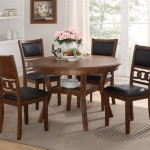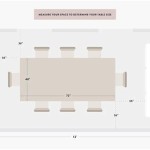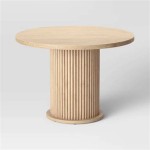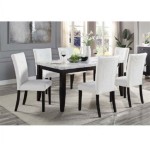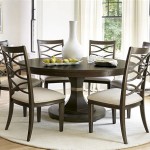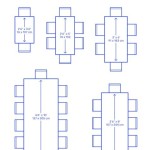Outdoor Wood Dining Table For 10: A Comprehensive Guide
An outdoor wood dining table designed to comfortably seat 10 individuals represents a significant investment in outdoor living and entertainment. Such a table becomes the focal point for gatherings, fostering memorable experiences with family and friends. Selecting the right wood dining table for this capacity requires careful consideration of several factors, including wood type, size, style, durability, and maintenance requirements.
Wood Selection: Understanding the Options
The choice of wood is perhaps the most critical factor influencing the longevity and aesthetic appeal of an outdoor dining table. Different wood species possess distinct characteristics that impact their resistance to weather, insects, and rot, as well as their overall appearance and cost.
Teak is widely regarded as a premium choice for outdoor furniture due to its naturally high oil content. These oils provide exceptional protection against moisture, insects, and decay. Teak's inherent durability allows it to withstand harsh weather conditions with minimal maintenance. Over time, untreated teak will develop a beautiful silver-gray patina, a characteristic prized by many. While teak is a superior option, its higher price point can be a deterrent for some buyers.
Cedar is another popular option known for its aromatic scent and natural resistance to insects and decay. It is less expensive than teak but still offers good durability for outdoor use. Cedar contains oils that repel insects and prevent rot, making it a suitable choice for outdoor furniture. It is also relatively lightweight, making it easier to move the table if needed. Cedar requires periodic treatment with a sealant or stain to maintain its color and protect it from the elements.
Acacia wood is a dense hardwood that offers a balance of durability and affordability. It is naturally resistant to rot and insects, making it a good choice for outdoor furniture. Acacia is known for its attractive grain patterns and warm color tones. It is an excellent option for those seeking a durable and aesthetically pleasing wood dining table without the high cost of teak. Regular sealing or staining is recommended to prolong its lifespan and maintain its appearance.
Pressure-treated pine is a budget-friendly option that has been chemically treated to resist rot and insects. The pressure-treating process infuses the wood with preservatives, making it suitable for outdoor use. While less expensive than other wood options, pressure-treated pine may not be as aesthetically pleasing and can require more frequent maintenance to prevent warping and cracking. It is crucial to select pressure-treated pine that is specifically designed for outdoor use and to follow proper finishing and sealing procedures.
Size and Dimensions: Ensuring Comfortable Seating
When selecting an outdoor wood dining table for 10 people, careful consideration must be given to its size and dimensions to ensure comfortable seating and adequate space for serving dishes. Overcrowding can detract from the dining experience, while a table that is too large can overwhelm the outdoor space.
As a general guideline, each person requires approximately 24 inches of table space for comfortable dining. Therefore, a table designed for 10 people should ideally be at least 8 feet (96 inches) long. The width of the table should also be sufficient to accommodate serving dishes and centerpieces without crowding the diners. A width of 40 to 48 inches is typically recommended for a table of this size.
The shape of the table also plays a role in determining its overall dimensions and seating arrangement. Rectangular tables are a common choice for seating larger groups, as they provide ample space and allow for easy conversation. Oval tables offer a similar seating capacity but with a softer, more rounded aesthetic. Round tables can also be used to seat 10 people, but they require a significantly larger diameter, typically around 72 inches, to provide adequate space for each diner.
Beyond the table's dimensions, consider the surrounding space and the placement of chairs. Ensure there is enough clearance around the table for diners to comfortably move around and pull out their chairs. A minimum of 36 inches of space between the table and any walls or obstacles is generally recommended.
Style and Design: Complementing the Outdoor Environment
The style and design of the outdoor wood dining table should complement the overall aesthetic of the outdoor environment. The table should blend seamlessly with the existing landscaping, architecture, and outdoor furniture.
For a rustic or traditional outdoor space, a solid wood table with a natural finish is a suitable choice. Look for tables with chunky legs, exposed joinery, and a slightly weathered appearance. These features evoke a sense of warmth and authenticity.
A more contemporary outdoor space benefits from a sleek and minimalist dining table. Tables with clean lines, simple silhouettes, and a smooth finish are ideal. Consider tables with metal accents or legs to add a touch of modern flair.
For a coastal or beach-themed outdoor area, a whitewashed or light-colored wood table can create a breezy and relaxed atmosphere. Tables with nautical-inspired details, such as rope accents or slatted tops, can further enhance the coastal aesthetic.
The choice of chairs is also crucial in complementing the table's style. Consider the material, color, and design of the chairs to create a cohesive and visually appealing outdoor dining set. Wicker chairs, metal chairs, or wooden chairs with cushions are all viable options, depending on the desired style and level of comfort.
The table's finish also influences its appearance and durability. A clear sealant can protect the wood from the elements while allowing its natural beauty to shine through. Staining the wood can enhance its color and grain patterns. Painting the wood can provide a more uniform and contemporary look.
Durability and Maintenance: Protecting the Investment
Ensuring the durability and longevity of an outdoor wood dining table requires proper maintenance and protection from the elements. Wood is a natural material that is susceptible to damage from moisture, sunlight, and temperature fluctuations. Regular cleaning, sealing, and storing the table properly can significantly extend its lifespan.
Regular cleaning is essential to remove dirt, debris, and mildew from the table's surface. Use a mild soap and water solution with a soft brush or cloth to gently scrub the table. Avoid using harsh chemicals or abrasive cleaners, as they can damage the wood's finish.
Sealing the wood with a protective sealant or stain is crucial to prevent moisture from penetrating the wood and causing rot or warping. The frequency of sealing will depend on the type of wood and the severity of the weather conditions. Generally, it is recommended to seal the table at least once a year, or more frequently in areas with high rainfall or humidity.
During periods of inclement weather, such as heavy rain or snow, it is advisable to cover the table with a waterproof cover to protect it from the elements. This will help prevent water damage and extend the table's lifespan. Consider storing the table indoors during the off-season to further protect it from the elements.
Consider the use of furniture pads or coasters to prevent scratches and stains on the table's surface. These simple accessories can help protect the wood from everyday wear and tear.
Inspect the table regularly for any signs of damage, such as cracks, splinters, or loose joints. Address any issues promptly to prevent them from worsening. Tighten any loose screws or bolts, and repair any cracks or splinters with wood filler or epoxy.
Cost Considerations and Budgeting
The cost of an outdoor wood dining table for 10 people can vary significantly depending on the type of wood, size, style, and features. Establishing a budget beforehand is essential to narrow down the options and avoid overspending.
Teak dining tables are generally the most expensive, followed by cedar and acacia. Pressure-treated pine tables are typically the most affordable option. However, the initial cost is not the only factor to consider. The long-term maintenance requirements and lifespan of the table should also be factored into the overall cost.
Consider the cost of any accessories, such as chairs, cushions, and covers, when budgeting for the dining set. These items can significantly add to the overall expense.
Shopping around and comparing prices from different retailers is crucial to find the best deal. Look for sales, discounts, and promotions to save money. Consider purchasing the table during the off-season when prices are typically lower.
Weigh the pros and cons of buying a new versus a used dining table. Used tables can be a more affordable option, but they may require some repairs or refinishing.
Consider the possibility of building a custom dining table. This can be a more affordable option for those with woodworking skills and access to the necessary materials.
The selection of an outdoor wood dining table for ten requires a deliberate approach, factoring in material, dimensions, style, durability, and budgetary considerations. This process ensures that the selected table is not only aesthetically pleasing but also a practical and enduring addition to any outdoor space.

Antibes 10 Seater Outdoor Teak Garden Set Dalby Living

Antibes 10 Seater Outdoor Teak Garden Set Dalby Living

10 Seater Dining Set 280cm Reclaimed Teak Outdoor Table Lowry

Summit 10 Ft Teak Dining Table Country Casual

Ambre Dining Table Teak For 8 10 People

Teak Patio Outdoor Dining Set For 10 Goldenteak

Fiori 10 Ft Grade A Teak Dining Table Country Casual

Ambre Dining Table Teak For 8 10 People

Antibes 10 Seater Outdoor Teak Garden Set Dalby Living

Rustic Farm Table 10 Ft Or 12 Foot Set W You Pick Chairs House Country Cabin Distressed Large Kitchen Dining Custom Sizes Colors Etsy Hong Kong

